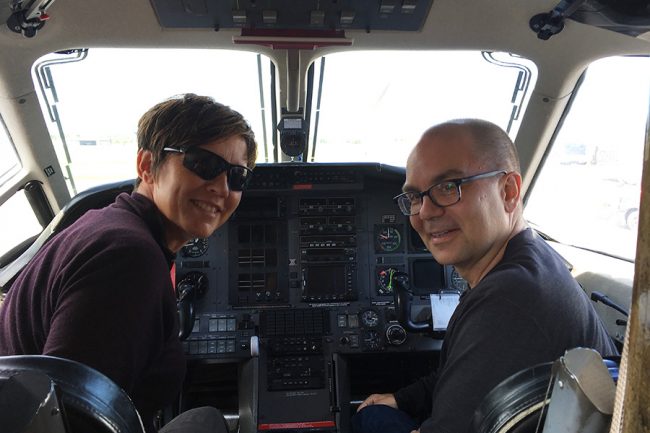
Mitigating indoor mould and optimizing air transportation in Northern Ontario are the first two collaborative projects between Indigenous community leaders and U of T researchers to get underway through the Reconciliation Through Engineering Initiative (RTEI).
Launched last December by the Centre for Global Engineering (CGEN), RTEI will ultimately identify six projects to improve access to clean drinking water, food security, housing, health care, transportation and communication systems in Indigenous communities across Canada.
All RTEI projects aim to find sustainable engineering solutions through community-driven, multidisciplinary and Two-Eyed Seeing collaborations, leveraging the expertise of both Indigenous community members and U of T researchers specializing in diverse fields.
“In today’s challenging environmental climate, a Two-Eyed Seeing approach to research is critical to building sustainable futures for all,” says Sonia Molodecky, RTEI program lead.
The first project focuses on developing a holistic, land-based mould-mitigation framework for Indigenous housing on Georgina Island in Lake Simcoe, north of Toronto. The work, which can be used to support other First Nations communities across Northern Ontario, is led by Professors Marianne Touchie (CivMin, MIE), Liat Margolis (Architecture), Bomani Khemet (Architecture) and natural building designer Becky Big Canoe of the Chippewas of Georgina Island First Nation.
Mould contamination, which is associated with respiratory illnesses, affects 44% of houses in First Nation communities in Canada. And as Becky Big Canoe has seen first-hand, previous attempts to address the spread of mould were unsuccessful. A key factor of failed mould remediation strategies was the lack of consultations with residents.
“The solutions weren’t sustainable, did not fit the environment or take into account high occupancies,” says Big Canoe, whose prototype of a land-based, high-occupancy house will be incorporated into the team’s ventilation and building-envelope design.
“I think we understand what the technical solutions are,” says Touchie, who will focus on ventilation systems. Khemet will work on the building envelope, and Margolis on the house’s soft-scape surroundings.
“The key to success in this project is actually gaining an understanding of the ways in which communities use their houses, what housing needs aren’t met, and what they’d like to see done differently. That is why Becky’s expertise and prototype will play a vital role in this.”
RTEI’s second project will develop techniques for more efficient air transportation to Indigenous communities in Northern Ontario. The work is led by Professors Chris Beck (MIE), Chi-Guhn Lee (MIE), Shoshanna Saxe (CivMin), Tracey Galloway (Anthropology) and Michael Widener (Geography).
In Northern Ontario, the reliability of air service, both cargo and passenger, is hampered by persistent challenges. These include aging infrastructure, limited weather information and navigational supports, as well as long flight paths between communities and limited emergency supports. These challenges significantly affect food security for these communities, which rely on air transport for their food.
These challenges are further compounded by extreme weather patterns. Even de-icing, a matter perceived as routine in southern Canada, is more complex to operationalize in the North.
In addition to consulting with Indigenous community leaders, the engineering researchers are working closely with Galloway — drawing on her long history of work in remote Northern Canada — and Widener — an expert in geographic systems and the interplay between accessibility and wellbeing — to understand the human impact of their proposed solutions.
In the second collaboration, Beck’s team will work closely with Northern businesses to develop models that optimize travel routes and cargo/passenger transportation.
“We have a lot of research about transportation optimization that’s been developed over the last 50 years, but almost always, this research is within the context of the South, where there’s a market environment and plenty of transportation links,” says Beck, who recently visited the airports in First Nation communities Webequie, Neskantaga and Eabametoong.
Meanwhile, Lee’s team will apply machine learning techniques to manage uncertainty, such as when adverse weather conditions or emergencies lead to a cascading effect of unknowns in air transport operations.
“If there’s an emergency situation where a plane carrying essential supplies can’t land at the optimized destination, we would have to find an alternative that causes the least disruption,” says Lee. “Our work aims to minimize the impact of uncertainty.”
Saxe’s group will analyze the current physical infrastructure of these airports to identify their impact on air service. Her lab is currently engaging with both users and providers of air travel services to learn about their experiences.
“It’s most important that we’re listening to learn about a context different from our lived experiences as Southerners,” adds Saxe.
Researchers across both projects emphasize the importance of taking the time to find the appropriate solutions, rather than developing a quick fix.
“Strange as it sounds, we will spend most of the next year listening: sitting down with experts, decision makers, Elders and community members,” says Galloway. “We need to listen to the larger, ongoing conversation happening in Canada around self-determination for Indigenous people, and ask our partners and collaborators how we can support their goals through research.”
-This story was originally published on the University of Toronto’s Faculty of Applied Science and Engineering News Site on November 14, 2019 by Liz Do